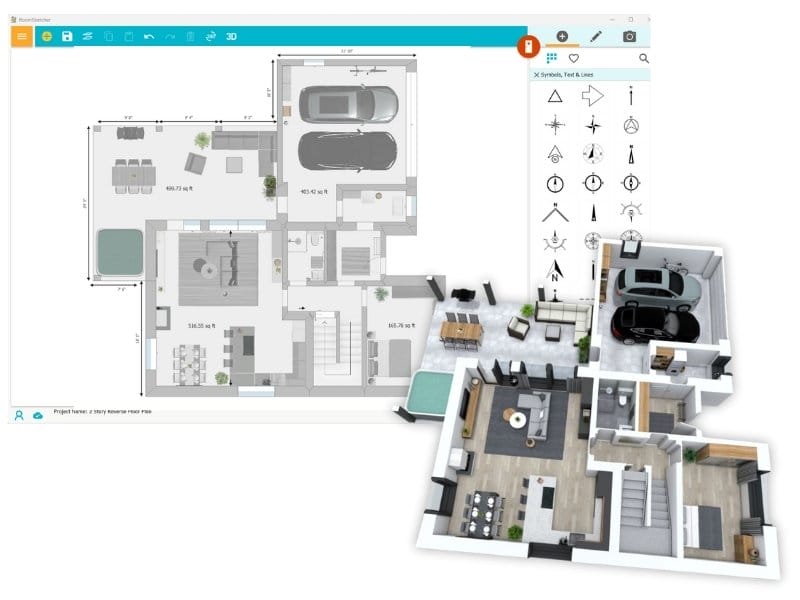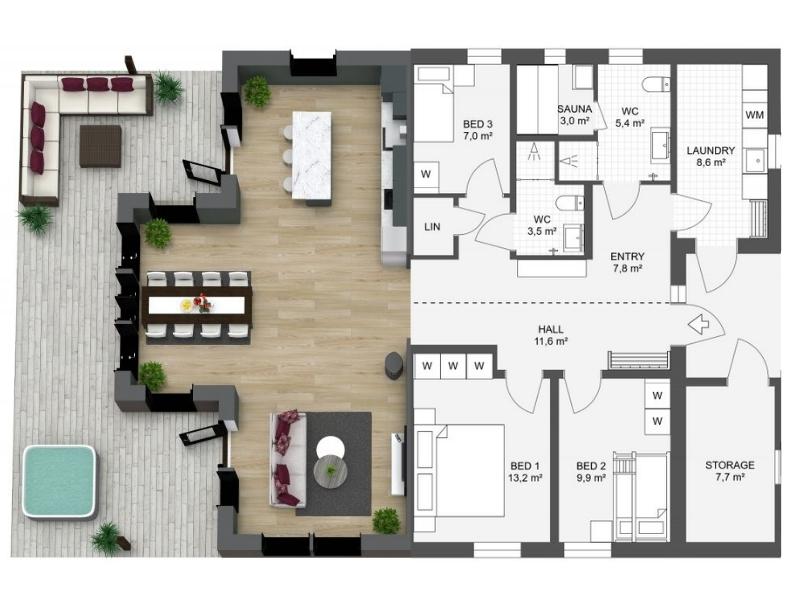PlanUp vs. Houzz Pro: Head-to-Head
Not all floor plan tools work the same way, and the details can make a big difference. Below, we break down what sets PlanUp and Houzz Pro apart so you can quickly see which one might work best for you.

Comparison Summary:
PlanUp is a simple tool for real estate professionals and energy surveyors who need quick floor plans. Houzz Pro is more advanced, offering 3D planning and business tools for project management and client communication. But if you’re looking for something that’s both powerful and easy to use, RoomSketcher is the better choice.
If you work with floor plans, you know how important it is to have the right software. The right tool can save you hours, impress your clients, and even help you win more business.
Today, we’re diving deep into two popular options: PlanUp and Houzz Pro. Let’s check how they stack up, and see why many professionals are turning to RoomSketcher instead.
Who Are These Tools For?
PlanUp is a favorite among real estate professionals and domestic energy surveyors in the UK. Its main mission? To make creating simple, accurate floor plans for property listings fast and painless, and help with energy survey reporting. If you’re an estate agent or property marketer who wants to whip up basic floor plans in minutes, PlanUp was built with you in mind.
Houzz Pro, on the other hand, is a full-featured business platform for interior designers, contractors, and remodelers, especially those already active in the Houzz ecosystem. It’s more than just a floor plan tool; it’s an all-in-one solution for managing projects, communicating with clients, and marketing your services.
Drawing Floor Plans

PlanUp uses a room-by-room drawing method. It’s quick for standard layouts, but if you need to tweak individual walls or create complex shapes, you might hit some limits.
Houzz Pro gives you more freedom. You can draw in both 2D and 3D, switch between views, and edit walls or rooms as you like. This is helpful if you want to experiment or present multiple options to clients.
2D and 3D Floor Plans

PlanUp provides basic 2D floor plans with a limited selection of fixtures, mainly essential bathroom and kitchen items. Customization is minimal, so your plans will have a standard look and feel.
The 3D floor plan feature is also quite basic. It offers only one carpet and one hardwood floor option, with a fixed viewing angle. This limits how much you can personalize your floor plans or showcase different design ideas.
Houzz Pro is stronger in 3D. It allows for interactive models and walkthroughs to help clients visualize the finished space. The platform also supports both black-and-white and colored 2D plans, but customization options are somewhat limited compared to specialized design tools.
If you want to add detailed measurements, custom symbols, or branded elements, you might find Houzz Pro’s 2D features a bit restrictive.
Furniture Libraries and Customization

PlanUp keeps things simple with a small library of basic fixtures, mostly for kitchens and bathrooms. There’s no option to customize these items or add a lot of detail.
Houzz Pro offers a broader selection of 3D furniture and decor, and you can integrate real products from the Houzz marketplace. While this can be helpful for presenting realistic designs to clients, the library isn’t as extensive or customizable as some users might like.
Business Tools
This is one area where the two platforms really diverge.
PlanUp is focused solely on floor plan creation, with no built-in business management or collaboration features. It’s a good fit for agents who want a simple tool for one specific task.
Houzz Pro, on the other hand, is an all-in-one platform. In addition to floor planning, you get tools for client management, marketing, scheduling, invoicing, and more. This can be a real plus if you want to run your business from a single dashboard, but it also adds complexity if you only need a floor plan software.
Pricing

PlanUp offers multiple pricing tiers. If you only need the occasional floor plan, you can pay as you go for £7.49 per plan. For those who create floor plans more regularly, PlanUp also has subscription options. These start at £19.99 per month for up to 5 floor plans, and go up to £39.99 per month for a package that includes 30 floor plans.
Houzz Pro is definitely on the higher end when it comes to pricing. If you want access to the 3D Floor Planner, you’ll need their “Essential” subscription, which costs $149 per month. The “Pro” subscription is available for $249 per month if you're looking for even more advanced features.
So, Which Is Better?
PlanUp and Houzz Pro both have their place in the world of floor plan software, but they’re designed for different users and workflows.
PlanUp is a simple choice for those who need to produce basic floor plans quickly. Houzz Pro is a more complex solution for professionals who want to manage projects and handle business tasks on the same platform.
If you need a tool that combines powerful floor plan creation, extensive customization, and an intuitive interface, without the limitations of PlanUp or the complexity of Houzz Pro, there are other options out there that might be a better fit.
Why Professionals Are Choosing RoomSketcher
While PlanUp and Houzz Pro each have their strengths, many users find themselves wishing for a floor plan tool that’s both genuinely easy to use and powerful enough to handle professional demands.
This is where RoomSketcher stands out.
A User-Friendly Interface That Makes Sense

One of the most common frustrations with both PlanUp and Houzz Pro is the user experience. PlanUp’s interface, while straightforward for basic tasks, can quickly become limiting if you want to create anything beyond the simplest floor plans. Houzz Pro, on the other hand, offers a wide range of features, but its interface can feel cluttered and overwhelming, especially if you’re only interested in floor planning.
RoomSketcher takes a different approach. Its interface is designed specifically for floor planning, making even advanced features easy to access and use. You can draw floor plans wall-by-wall with intuitive controls, and see your changes in real time. There’s no need to dig through complicated menus. Everything you need is thoughtfully organized, so you can focus on your project instead of figuring out the software.
Customization Options for Professional Results

Customization is another area where RoomSketcher truly excels. Unlike PlanUp, which offers only basic fixtures and minimal personalization, RoomSketcher gives you a rich library of over 7000 furniture items, materials, and symbols.
You can easily add detailed furnishings, color-code rooms, and annotate your plans with measurements and labels.
Branding your work is simple too. Just add your logo and save your preferred styles as templates for a consistent, professional look across all your projects.
Detailed 3D Visualization

For those who care about visualization, RoomSketcher offers advanced 3D features that neither PlanUp nor Houzz Pro can match.
With RoomSketcher, you can create lifelike 3D Photos and immersive 360 Views, helping clients and stakeholders experience a space before it’s built.
The ability to adjust viewing angles and materials means your presentations will always look polished and realistic.
Get Started for Free
RoomSketcher combines a user-friendly interface with powerful features. If you’re looking for a tool that lets you create impressive, customized floor plans quickly and easily, RoomSketcher is the clear choice.
Want to try it out? Create a free account and get started right away!
Don't forget to share this post!
Find More Comparisons Here:

The 8 Best Floor Plan Software Tools
The market is flooded with floor plan software options, each promising to make your processes easier and more efficient. We've put the top tools to the test!

PlanUp vs. RoomSketcher
Choosing between PlanUp and RoomSketcher for your floor plan needs? This article will help you decide.

Houzz Pro vs. RoomSketcher: Complete Comparison
Are you choosing between the Houzz Pro and RoomSketcher for your floor plan needs? Both are popular tools with large user bases, but have different strengths. This guide will help you decide which one best fits you.
